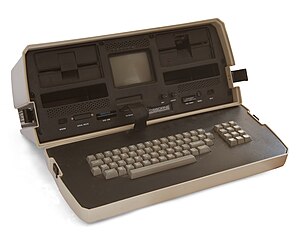Osborne I
 |
|
| Developer | Adam Osborne |
|---|---|
| Type | Portable computer |
| Release date | April 3, 1981 |
| Introductory price | US$1,795 (equivalent to $4,729 in 2016) |
| Discontinued | 1983 |
| Operating system | CP/M |
| CPU | Zilog Z80 @ 4.0 MHz |
| Memory | 64 kB RAM |
| Successor | Osborne Executive |
The Osborne 1 was the first commercially successful portable microcomputer, released on April 3, 1981 by Osborne Computer Corporation. It weighed 10.7 kg (24.5 lb), cost $1,795 US, and ran the CP/M 2.2 operating system. Powered directly from a mains socket as it had no on-board battery, though it was still classed as a portable device as it could be packed away and transported by hand to another location.
The computer shipped with a large bundle of software that was almost equivalent in value to the machine itself, a practice adopted by other CP/M computer vendors at the time.
Competitors such as the Kaypro II that used double sided drives and larger 9" screens that could hold a full 80x25 display quickly appeared.
The Osborne 1 was developed by Adam Osborne and designed by Lee Felsenstein. It was first announced in early 1981. Osborne, an author of computer books, decided he wanted to break the price of computers.
The Osborne's design was based largely on the Xerox NoteTaker, a prototype developed at Xerox PARC in 1976 by Alan Kay. The computer was designed to be portable, with a rugged ABS plastic case that closed up, and a handle. The Osborne 1 was about the size and weight of a sewing machine and was advertised as the only computer that would fit underneath an airline seat. It is now classified as a "luggable" computer when compared to later laptop designs such as the Epson HX-20.
Despite its unattractive design and heavy weight—the Osborne 1 reportedly resembled "a cross between a World War II field radio and a shrunken instrument panel of a DC-3", and Felstenstein confessed that carrying two units four blocks to a trade show "nearly pulled my arms out of their sockets"—the computer amazed observers. BYTE wrote, "(1) it will cost $1795, and (2) it's portable!" ($1795 is the equivalent of $4729 today.) The bundled word processing, spreadsheet, and other software alone was worth $1,500; as InfoWorld stated in an April 1981 front-page article on the new computer after listing the included software, "In case you think the price printed above was a mistake, we'll repeat it: $1795."
...
Wikipedia
